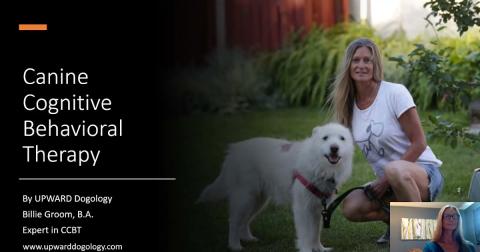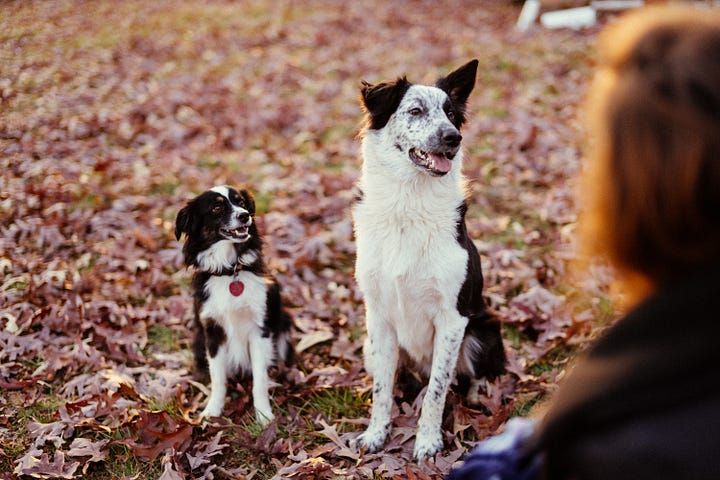Adolescent Canine Behavior

by Billie Groom, BA
Expert in Canine Cognitive Behavioral Therapy
Abstract
This article is a compilation of three of my published works; 1) an article introducing Canine Cognitive Behavioral Therapy, 2) a PowerPoint presentation for the Animal Behavior Society Conference explaining the correlation between brain development and behavior during the adolescent stage, and 3) one of my podcast episodes that illuminates the potential oversight of a scientific study on adolescent behavior.
The goal of this article is to provide evidence to substantiate the benefits of including Canine Cognitive Behavioral Therapy (CCBT) in scientific studies on canine behavior and into mainstream dog education and animal welfare.
Introduction
As a canine consultant and behaviorist, I work one-on-one with clients, virtual and live, which is one of the most challenging pedagogies in the canine training and behavior industry. I work exclusively with dogs over six months of age, with 70% in the adolescent stage (six to twenty-four months). 84% of my clients have adopted dogs with disadvantaged pasts. 98% of my clients hired 1-3 certified trainer(s) and/or a Behavioral Veterinarian prior to hiring me. 64% were advised to surrender or euthanize their dog. 99.2% kept their dog. These statistics are generated from 150 clients per year over ten years.
I contribute my success to my methodology, Canine Cognitive Behavioral Therapy (CCBT).
The Adolescent Dog
Puppies possess cognitive skills which tend to aid in training and socialization. Puppies are commonly eager to learn and respond well to reinforcements that encourage wanted behaviors and positive thought patterns.
As puppies mature into adolescent dogs, beginning at approximately six months of age, they commonly display behaviors not dissimilar to those of human teenagers. Behaviors are driven by emotions without consideration of repercussions or the feelings of others. Despite knowing “right from wrong,” adolescent dogs choose to do behaviors they know are wrong. These actions may be induced by curiosity, “What will happen if I don’t come home at curfew” (human), or “What if I don’t come when called?” (canine), or to achieve a goal, such as getting attention, acquiring objects, or simply being left alone. When behaviors result in achieving the desired outcome, the behaviors are likely to be transferred to other situations and can easily become habit. Habits tend to occur subconsciously and are triggered by the repetition of a mental experience.
Cognitive skills developed during adolescence encourage curiosity yet, dogs are unable to process quickly enough to make educated decisions, leading to reactive behaviors associated with fear, anxiety, and aggression. Fear and anxiety often lead to challenging and upsetting behaviors, including, but not limited to hiding, shaking, barking, biting, lunging, urinating, defecating, refusing to eat, play or exercise, destructive behaviors, and anti-social tendencies. These behaviors are often not prevalent during puppyhood.
Dogs in the adolescent stage who “know right from wrong behaviors” consciously perform acts of defiance, and scientific studies prove levels of “obedience” decline in the adolescent stage. These changes in behaviors can escalate to behaviors associated with aggression, leading to surrender and even euthanasia.
Dr. Naomi Harvey performed a peer-reviewed, scientific study whereby her and her colleagues studied the connection of adolescent conflict behavior in respect to their attachment to humans. They devised exercises using positive reinforcements to determine change in behavior in respect to obedience and emotional connection with humans and compared the results to those during puppyhood. The over-all goal was to learn more about adolescent dog behavior, a field of study Harvey believes is underrepresented.
Let’s consider the nature of this study. They applied reinforcement-based exercises. Would the outcome of this study differ had they applied exercises that harness cognitive thought patterns – the same thought patterns driving the change in behaviors? Perhaps the design of the study perpetuated the outcome.
To explore this theory, we must 1) understand the design and intent of the methodologies, and 2) consider the impact of brain development in the adolescent stage on the effects of these methodologies.
Methodologies
Conditioning Methodologies:
Conditioning methodologies dominate mainstream dog education. The most common method is that of Operant Conditioning, a scientifically proven methodology designed to instill positive thought patterns and to teach expected behavior. The process encourages and discourages wanted and unwanted behavior respectively, using reinforcements. Specific techniques include positive reinforcement training, negative reinforcement training, and balanced training, and there are, of course, different forms of application of each technique.
Counter and Classical Conditioning are designed to change behavior using associative elements and desensitization. By establishing positive, commonly tangible, elements, the subject associates the positive with the negative stimuli thereby changing the reaction toward the negative stimuli. Desensitization is a form of repetition whereby the negative stimuli is introduced repeatedly at appropriate increments. The two techniques work in combination.
Conditioning methods are designed to repetitiously apply tangible objects as reinforcements in a reactive nature.
Cognitive Behavioral Therapy (CBT):
CBT is a scientifically proven methodology designed to change perception to change behavior. Through the application of platform exercises harnessing cognitive thought patterns, the brain is reset, allowing for thought processing, and decision making. Unlike conditioning methods, CBT does not require a tangible element, and does not teach, encourage, or discourage behaviors. As perception changes, the need to do a behavior to achieve a goal changes, thus changing behavior. The emotions toward the stimuli may or may not change at that time.
CBT takes a proactive approach to prevent reactive behaviors by resetting the brain. CBT recognizes preconceived thought patterns derived from learned behavior and experiences, (positive and/or negative,) and acknowledges the ability to think cognitively.
Brain Development:
The hippocampus, which stores memory, particularly long-term memory, works in conjunction with the amygdala, the part of the brain responsible for encoding surroundings and determining emotions, particularly fear. During adolescence, the connectivity between these two components is compromised.
Inhibitory neurons organize brain activity and synchronize networks allowing for processing before reacting. These neurons begin to develop but are not fully developed until adulthood.
This delayed genesis results in emotions directing behavior without the ability to fully process, remember, and assess, leading to dogs being described as reactive or unpredictable.
Associative training and desensitization, discussed earlier in this article, require long term memory which is impaired during adolescence, leading to inconsistent progress and unpredictable behaviors. Dogs may connect the associative element in one situation, and yet not in another. Reactivity toward a stimulus may decrease during a walk with repeated exposure; however, with the same stimulus the following day, the dog shows no signs of recollection, and the handler is “back to square one.”
Associative techniques and desensitization require the stimulus to be present, which can, and should, occur incrementally to avoid flooding. Flooding occurs when a subject is exposed to a stimulus at a rate, or in a manner, that causes discomfort or extreme emotional response. Because conditioning methods require the stimulus to be present, while delayed genesis inhibits the ability to process the stimulus, it can be challenging to effectively incorporate reactive reinforcements.
CBT requires repetition, however, not in the form of desensitization. Exercises that harness cognitive skills are practiced repeatedly to reset the brain in situations where there is no stress or discomfort. The exercises, or components there of, act as the transferable element, allowing for processing and decision making to occur habitually in all situations, therefore not requiring long term memory of a specific stimulus. Essentially, CBT emulates the role of inhibitory neurons.
Common Recommendations
Behavioral experts, including neuroscientists and behavioral veterinarians, recommend continuing with positive reinforcement training during the adolescent stage despite knowing the limitations of conditioning methods during this stage.
Continuing to apply positive reinforcement training commonly results in increased unwanted behavior and/or increased fear, anxiety, or aggressive behaviors. Dogs view their human as not recognizing their thought patterns or respecting what is important to them. Dogs realize their human does not have the skills to effectively communicate, or to calmly manage challenging or uncomfortable situations. This change in perception of the human leads to increased unwanted behavior and a decreased bond between the dog and the human, often resulting in surrender, abuse, or euthanasia.
In response to the ineffectiveness of conditioning methods during this stage, industry experts recommend distracting the dog from the stimuli, avoiding potentially challenging situations, or preventing unwanted behavior through increased restrictions. These suggestions only serve to suppress cognitive development and increase frustration.
Experts also recommend increased exercise, and provide suggestions for basic coping mechanisms, which, although not negative in theory, can be unrealistic for pet parents living in urban areas, and they simply mask the problems. Experts convince people there is nothing that can be done, and encourage patience, knowing that once inhibitory neurons develop, and other brain developments occur during early adulthood, conditioning methods will take effect. Patience is required for all methods; however, expecting shelter staff, pet parents, fosters, adopters, and rescuers to rely on patience while unwanted behaviors increase and bonding decreases, is unfair to the people and is often a death sentence for the dog.
Conclusions
Neuroscience, perhaps unintentionally, explains why conditioning methods are limiting, ineffective, and/or counter productive during the adolescent stage, and substantiates the need for CCBT in mainstream dog education.
Using reinforcement-based exercises in scientific studies on adolescent dog behavior can be restrictive and can lead to conclusions which perpetuate the theory that dogs are challenging and “teenage” like during the adolescent stage. Conducting scientific studies which harness cognitive skills driving behaviors will likely produce different results, thus denouncing societal misconceptions surrounding adolescent dog behavior.
Based on intent and principles guiding individual methodologies, and brain development occurring in the adolescent stage, we can conclude that positive reinforcement training is the preferred method during puppyhood, CCBT during the adolescent stage, and force free conditioning methods and CCBT during adulthood. It is important to be flexible, as not all dogs think and learn the same way. There is no “one right way” to work with a dog.
The goal should not be “to be right,” but rather, “to get it right.”
The Solution
CCBT is proven to address behaviors common among adolescent and adopted dogs, and ones associated with anxiety and aggression. CCBT is proven to increase successful adoptions, decrease surrenders, eliminate the perceived need for aversive methods or tools, and prevent behavioral euthanasia.
There is a shift in mindset toward recognizing emotions and cognitive abilities within all non-human species. CCBT allows for autonomy and agency by encompassing a holistic approach to learning, encouraging kindness over dominance, and securing the human-animal bond.
Resources:
Dr. Kathy Murphy BVetMed, DPhil, CVA, CLAS, MRCVS - Behavior Vets (behaviorvetsnyc.com)
The information and statistics presented in this article are those of Billie Groom, unless otherwise stated. Billie Groom is the sole author of this article.





Comments ()